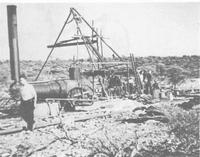


Chapter 10
I 1. Introduction
II 2. The Role Of Technology
III 3. Some Highlights Of Australian Minerals Technology
i Gold
ii Copper
iii Lead-zinc-silver
iv Technology in iron ore mining
v Iron and steel technology
vi Nickel
vii Mineral sands
viii Bauxite, alumina, aluminium
IV 4. Other Technological Achievements (in brief)
V 5. Export Of Technology
VI 6. Education And Research
VII 7. The Scientific Societies
VIII 8. Conclusion
References
Index
Search
Help
Contact us

Gold
Western Australia continues to be the dominant producing and exploration region, and it is fitting to make special mention of the technological advances in the Kalgoorlie field which constitute a major contribution by Australians to the metallurgy of gold. The present practices in the several Kalgoorlie mines, and in fact throughout all the goldfields, are the culmination of continuous research at the plant level over a period of 90 years, although the pace of development has been halted from time to time by factors such as two World Wars and the subsequent inflation and, of course, by increased costs of deeper mining. The scale and scope of the metallurgical studies has been such that at one stage the five operating Kalgoorlie mines were employing five different combinations of cyanidation, flotation and roasting, including one inwhich the entire ore was dry-milled and roasted prior to cyanidation.

The experiences of the Kalgoorlie mines were closely studied and features of the techniques were adopted in other parts of the world where tellurides were important, including Fiji, the Kirkland Lake field in Canada and Cripple Creek in Colorado. With the telluride problem mastered it is now recognised that the ultimate limiting factor in overall recovery from ores of this type is the close association of portion of the gold values with pyrite, arsenopyrite or other sulphides, and that the function of roasting is to expose the gold values in the porous oxide product resulting from roasting. Kalgoorlie studies of the roasting process showed the need for critical control of temperatures to ensure exposure of the gold whilst avoiding re-sealing of the porous oxide grain. In extreme cases, notably where association with arsenopyrite is involved, roasting even with critical control may be ineffective. This proved to be the case at Wiluna, where both arsenopyrite and stibnite were present, and the complicated alternative of smelting the roasted flotation concentrate in a lead blast furnace was employed at one stage.
Currently the most important new technique in the Western Australian goldfields, and indeed throughout Australia, is the carbon-in-pulp (CIP) variation of the standard cyanidation process. The standard process involved precipitation of the dissolved gold from a filtered and clarified pregnant solution by a reducing agent such as zinc dust or activated carbon. The CIP variation avoids the expensive and difficult filtration and clarification step, and has especial advantages in treating clayey surface deposits. The remarkable expansion of gold production throughout Australia in the 1980s owes much to the CIP process. A related variation, the resin-in-pulp process, is also under study. Another growing activity is heap leaching cyanidation which, when applicable, lends itself to treatment of extremely low grade ore or residues.

 |
Australian Academy of Technological Sciences and Engineering |  |
© 1988 Print Edition pages 738 - 739, Online Edition 2000
Published by Australian Science and Technology Heritage Centre, using the Web Academic Resource Publisher
http://www.austehc.unimelb.edu.au/tia/705.html